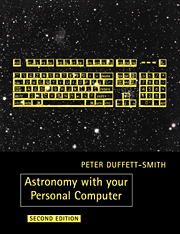Book contents
- Frontmatter
- Contents
- Preface
- Using your personal computer for astronomy
- DEFAULT: default value input routnine & YESNO: ‘Y’ or ‘N’ input routine
- MINSEC: converts between decimal hours/degrees and minutes/seconds form
- JULDAY: calendar date to Julian day number since 1900 January 0.5
- CALDAY: Julian day number since 1900 January 0.5 to calendar date
- TIME: converts between local civil and sidereal times
- EQHOR: converts between equatorial and horizon coordinates
- HRANG: converts between right ascension and hour angle
- OBLIQ: calculates the value of the obliquity of the ecliptic
- NUTAT: finds corrections for nutation in longitude and obliquity
- EQECL: converts between equatorial and ecliptic coordinates
- EQGAL: converts between equatorial and galactic coordinates
- GENCON: converts between any of the coordinate systems
- PRCESS1: approximate precession of equatorial coordinates & PRCESS2: rigorous precession of equatorial coordinates
- PARALLX: converts between geocentric and apparent position
- REFRACT: calculates the effect of atmospheric refraction
- RISET: finds the circumstances of rising and setting
- ANOMALY: solves Kepler's equation for elliptical motion
- SUN: finds the ecliptic coordinates of the Sun
- SUNRS: finds the circumstances of sunrise and sunset
- PELMENT: returns the orbital elements of the major planets
- PLANS: finds the position of a planet
- MOON: finds the position and parallax of the Moon
- MOONRS: finds the circumstances of moonrise and moonset
- MOONNF: finds the times of new and full moon
- ECLIPSE: finds the circumstances of lunar and solar eclipses
- DISPLAY: displays an eclipse in graphical form
- ELOSC: finds positions from osculating elliptical elements
- RELEM: converts elliptic orbital elements from one epoch to another
- PCOMET: finds the position of a comet from parabolic elements
- PFIT: finds parabolic elements from observations & EFIT: finds elliptical elements from observations
- List of variables
- Bibliography
- Index
- PROGRAMS AVAILABLE ON DISK
SUN: finds the ecliptic coordinates of the Sun
Published online by Cambridge University Press: 17 February 2010
- Frontmatter
- Contents
- Preface
- Using your personal computer for astronomy
- DEFAULT: default value input routnine & YESNO: ‘Y’ or ‘N’ input routine
- MINSEC: converts between decimal hours/degrees and minutes/seconds form
- JULDAY: calendar date to Julian day number since 1900 January 0.5
- CALDAY: Julian day number since 1900 January 0.5 to calendar date
- TIME: converts between local civil and sidereal times
- EQHOR: converts between equatorial and horizon coordinates
- HRANG: converts between right ascension and hour angle
- OBLIQ: calculates the value of the obliquity of the ecliptic
- NUTAT: finds corrections for nutation in longitude and obliquity
- EQECL: converts between equatorial and ecliptic coordinates
- EQGAL: converts between equatorial and galactic coordinates
- GENCON: converts between any of the coordinate systems
- PRCESS1: approximate precession of equatorial coordinates & PRCESS2: rigorous precession of equatorial coordinates
- PARALLX: converts between geocentric and apparent position
- REFRACT: calculates the effect of atmospheric refraction
- RISET: finds the circumstances of rising and setting
- ANOMALY: solves Kepler's equation for elliptical motion
- SUN: finds the ecliptic coordinates of the Sun
- SUNRS: finds the circumstances of sunrise and sunset
- PELMENT: returns the orbital elements of the major planets
- PLANS: finds the position of a planet
- MOON: finds the position and parallax of the Moon
- MOONRS: finds the circumstances of moonrise and moonset
- MOONNF: finds the times of new and full moon
- ECLIPSE: finds the circumstances of lunar and solar eclipses
- DISPLAY: displays an eclipse in graphical form
- ELOSC: finds positions from osculating elliptical elements
- RELEM: converts elliptic orbital elements from one epoch to another
- PCOMET: finds the position of a comet from parabolic elements
- PFIT: finds parabolic elements from observations & EFIT: finds elliptical elements from observations
- List of variables
- Bibliography
- Index
- PROGRAMS AVAILABLE ON DISK
Summary
The Sun's celestial coordinates are determined by its position in its apparent orbit of the Earth. Although the Earth actually orbits the Sun, it seems to us that it is the Sun which is in orbit about the Earth, and for the purposes of calculating the Sun's position it is convenient to regard this as the case. We can then compute the ecliptic longitude of the Sun for a given instant and, since the Sun-Earth orbit defines the plane of the ecliptic, we can take the ecliptic latitude to be 0. The right ascension and declination can be found by using routine EQECL (2000) followed by EQHOR (1500) if we wish to know the Sun's azimuth and altitude as well.
Subroutine SUN calculates the true geocentric ecliptic longitude of the Sun, SR, and its distance from the Earth, RR, at the instant given by UT (Universal Time, hours), DY (integer days), MN (months), and YR (years). The time may also be expressed as a fraction of a day and added to the value of DY, in which case UT must be set to 0. The true ecliptic latitude may be assumed to be 0 (always correct to within 1.2 arcseconds). SR is the longitude referred to the mean equinox of date and is the quantity required in the calculation of geocentric planetary positions.
- Type
- Chapter
- Information
- Astronomy with your Personal Computer , pp. 115 - 122Publisher: Cambridge University PressPrint publication year: 1990



